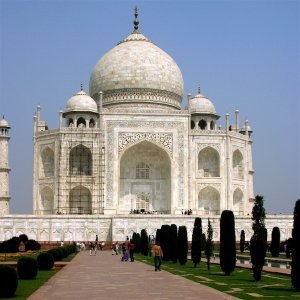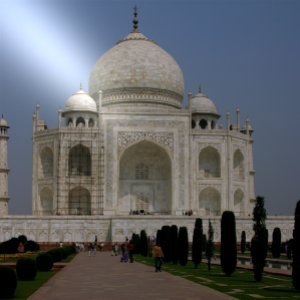| 6.6. Lighting Effects | ||
|---|---|---|

|
6. Light and Shadow Filters |  |
Figure 17.122. The same image, before and after applying Lighting filter

Original image

Filter “Lighting Effects” applied
This filter simulates the effect you get when you light up a wall with a spot. It doesn't produce any drop shadows and, of course, doesn't reveal any new details in dark zones.
When Interactive is checked, parameter setting results are interactively displayed in preview without modifying the image until you click on OK button.
If Interactive is not checked, changes are displayed in preview only when you click on the button. This option is useful with a slow computer.
Any other options are organized in tabs:
Makes destination image transparent when bumpmap height is zero (height is zero in black areas of the bumpmapped image).
Creates a new image when applying filter.
For quick CPU...
You can specify the distance of the light source from the center of the image with this slider. The range of values is from 0.0 to 2.0.
In this tab, you can set light parameters. With Light 1 ... Light 6 you can create six light sources and work on each of them separately.
The filter provides several light types in a drop-down list:
Displays a blue point at center of preview. You can click and drag it to move light all over the preview.
The blue point is linked to preview center by a line which indicates the direction of light.
This deletes the light source (light may persist...).
When you click on the color swatch, you bring a dialog up where you can select the light source color.
With this option, you can set light intensity.
Determines the light point position according to three coordinates: X coordinate for horizontal position, Y for vertical position, Z for source distance (the light darkens when distance increases). Values are from -1 to +1.
This option should allow you to fix the light direction in its three X, Y and Z coordinates.
With this option, you can decide whether all light sources must appear in the Preview, or only the source you are working on.
You can save your settings with the and get them back later with the .
These options don't concern light itself, but light reflected by objects.
Small spheres, on both ends of the input boxes, represent the action of every option, from its minimum (on the left) to its maximum (on the right). Help pop ups are more useful.
With these option, you can set the amount of original color to show where no direct light falls.
With this option, you can set the intensity of original color when hit directly by a light source.
This option controls how intense the highlight will be.
With this option, higher values make the highlight more focused.
When this option is checked, surfaces look metallic.
In this tab, you can set filter options that give relief to the image. See Bump mapping .
With this option, bright parts of the image will appear raised and dark parts will appear depressed. The aspect depends on the light source position.
You have to select there the grayscale image that will act as a bump map. See Bump Map plug-in for additional explanations.
This option defines the method that will be used when applying the bump map; that is, the bump height is a function of the specified curve. Four curve types are available: Linear, Logarithmic, Sinusoidal and Spherical.
This is the maximum height of bumps.
When you check this box, the following option is enabled:
You have to select there a RGB image, present on your screen. Please note that for this option to work you should load another image with GIMP before using it.
An example can be found at [BUDIG01].